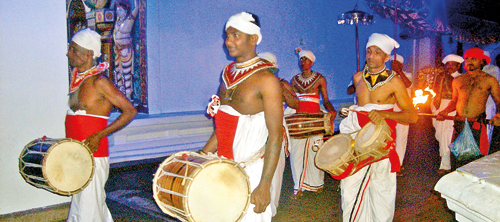Give ear to the different beats as the perahera passes by

Keeping a family tradition alive: Saman on the daula (in the centre) and other drummers performing a Hevisi pooja
The annual Esala Perahera or the Sri Dalada Perahera in Kandy commenced with the ‘Kap Situweema’ on August 12 at the Sri Maha Vishnu Devalaya. For five days, the deity’s ‘abarana’ (insignia) were taken around the Devalaya premises in a procession known as the athule (inside) perahera. This has only a flag bearer, three drummers and the ‘horanewa’ (wind instrument) player. A Hevisi pooja (drumming) was performed in honour of the deity.
The main drummer was Saman, a young man who had organized the drummers for this purpose. After his father’s death, he has a duty and a responsibility to continue the tradition of the family, he says.
Saman plays the daula in the Hevisi pooja for the Thevava at the Vishnu Devale for the Aluyama Duraya Poojava (early morning), the Hendae Duraya (evening) poojava. He proudly announced “I have won many awards for the best troupe as well as the Presidential Award for playing the daula and tammettama.” The Hevisi poojava is the drumming of the thammettama and daula accompanied by the horaneva.
Drums are a part of our cultural heritage. They are mentioned in the Mahawamsa and even before the 18th century, foreign travellers to the island such as Ibn Battuta, Fa Hien and Robert Knox had written about the drums used in the country.
During the time of our kings, ana bera was used for royal proclamation.The journey of a king was made known by the beating of a drum. When a criminal was taken for beheading, a vada bera was used, mala bera in funeral processions and rana bera when the Army went to war. Drums were also used for pleasure in the King’s Court.
At present, drums are used for Buddhist rituals and ceremonies. The Kandy Esala Perahera is where one sees and hears a selection of up-country drums. For each group of dancers, there is a specific type of drum to help them keep in step.
Saman explained the order in which the Vishnu Devale Perahera is organized. “First the flag bearers, followed by Horane, Thaalam ( cymbals), Daul, Tammettam, Daul, Tammettam, daul,Tammettam.
“The Daula gives a ‘Jeng Handa’(sound) and will be heard by the Hevisi drummers following them and the ‘dongkara handa’ (the echoing sound) will be lessened.” The geta bera is played for a group of ‘Ves’ dancers.
The Sri Dalada Maligawa, Natha, Kataragama and Patthini Devala will have troupes playing the geta bera, udekkiya, dandu beraya and karakawana rabana. The mridangam and other drums used by Hindus will be played in the Kataragama Devale procession, in addition to the up-country drums.
The geta beraya is played on ceremonial occasions as it is the main drum used in religious ceremonies and rituals. The right side is covered with the hide of a monkey, the other with cattle hide and it is played with both hands.
In the daula, both faces of the drum are covered with cattle hide.The drum is painted and decorated with brass motifs. It is played with a ‘Kadippu’ – a stick on one face and the other with the hand.
The thammettama is like a Bongo, a pair and has two separate drums of different size, a twin set also known as pokuru beraya. The top is covered with cattle hide, one stretched lightly and the other tight. It is played with two sticks fashioned out of cane or kirindi where the end is curved to form a ring. These are known as ‘kaduppu’. The wood used is Milla, Jak, Ehela or Kohomba.
The dandu beraya carved by bamboo is tied at the waist of the drummer and is used for folk dances in the perahera. The drummer uses two sticks made out of Atteriya. Animal hide is not used.
The karakawana rabana, a spinning rabana is one faced. Painted in bright colours, the player spins four rabanas balancing on four sticks connected to a handle. At times they spin the rabana and throw it in the air and catch it safely.
The udekkiya, a colourfully lacquered instrument played with one hand is made of Handun, Jak, Ehela, Kohomba and Gansuriya. Goat, monkey or monitor lizard hide is used to cover the two faces of the drum, which has an hourglass shape. This drum is played in the Naiyandi dance performance.
Exhibiting their aesthetic sense, the drummers drum and dance under the star-spangled Esala night sky. Look out for them as the Esala perahera parades the streets of Kandy.


